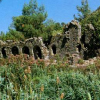
Olympos is located on the Antalya-Finike road. In order to go to Olympos, it is necessary to make a turn from Ulupinar, when a sign pointing to the ruins can be seen. A narrow but beautiful road leads to the beach of Olympos. In order to get to the ruins, one must pass the creek and walk a little on a wide beach which will take you to the creek that passes across Olympos. Olympos was set up in the Hellenistic period. Coins from the city, which were printed in the second century B.C., have been found during excavations. In 100 B.C., Olympos became one of the six leading cities that had the right to vote. In the first century B.C., pirates became so fond of the city that Olympos almost became a settlement area for the pirates. In 78 B.C., the Roman commander Servilius Isaurieus drove out the pirates and added the city to Roman territory. During the Roman era, the city became very famous with the cult of the blacksmith god Vulcan (Hephaestus) in nearby Çirali, where natural gases keep a number of flames burning perpetually.
Opramoas of Rhodiapolis, who helped restore all the Lycian cities in the second century B.C., also gave a hand to Olympos. He helped in the repair and restoration of many buildings in the city. In this way, Olympos had the most prosperous era of its history during this century. After this golden era, pirates continued to trouble the city. As a result of various attacks made by these pirates, the wealthy city became poorer and lost its significance. After this, the city survived only as a small, insignificant city.
The city enjoyed something of a revival when the knights of Venice, Genoa, and Rhodes came to spread themselves around the Mediterranean. However, the city lost all its charm after the Ottomans established superiority over the seas. Olympos was totally abandoned in the 15th century.
Olympos is spread across the two sides of the creek that passes through it. The hill that rises behind the tombs can be seen from the beach, and this was the acropolis of Olympos. The remains on the hill belong to a fortress which was built in the Middle Ages. Looking down from this hill, a lovely river which makes the city resemble Venice, is observed. The river was directed into a channel with polygonal walls built on its two sides. The two sides were joined by a bridge whose remains are still visible today.
On the other side of the river, there are the remains of a building with windows. This was the Turkish-style bath of the city. It is possible to walk across the river by stepping on the large pieces of stones in the river. Here, there is a theater of Olympos which is difficult to visit theater because of the presence of tall greenery. The theater's paradoes with vaults, pieces of decorated doors and niches scattered around, indicate that this theater was constructed by the Romans. Between the theater and the sea, there is a Byzantine basilica and city walls. On the other side of the river, there are the remains of a Turkish-style bath. The city's agora and gymnasium should have been in the wide, open area in the middle.
 Olympos is located on the Antalya-Finike road. In order to go to Olympos, it is necessary to make a turn from Ulupinar, when a sign pointing to the ruins can be seen. A narrow but beautiful road leads to the beach of Olympos. In order to get to the ruins, one must pass the creek and walk a little on a wide beach which will take you to the creek that passes across Olympos. Olympos was set up in the Hellenistic period. Coins from the city, which were printed in the second century B.C., have been found during excavations. In 100 B.C., Olympos became one of the six leading cities that had the right to vote. In the first century B.C., pirates became so fond of the city that Olympos almost became a settlement area for the pirates. In 78 B.C., the Roman commander Servilius Isaurieus drove out the pirates and added the city to Roman territory. During the Roman era, the city became very famous with the cult of the blacksmith god Vulcan (Hephaestus) in nearby Çirali, where natural gases keep a number of flames burning perpetually.
Olympos is located on the Antalya-Finike road. In order to go to Olympos, it is necessary to make a turn from Ulupinar, when a sign pointing to the ruins can be seen. A narrow but beautiful road leads to the beach of Olympos. In order to get to the ruins, one must pass the creek and walk a little on a wide beach which will take you to the creek that passes across Olympos. Olympos was set up in the Hellenistic period. Coins from the city, which were printed in the second century B.C., have been found during excavations. In 100 B.C., Olympos became one of the six leading cities that had the right to vote. In the first century B.C., pirates became so fond of the city that Olympos almost became a settlement area for the pirates. In 78 B.C., the Roman commander Servilius Isaurieus drove out the pirates and added the city to Roman territory. During the Roman era, the city became very famous with the cult of the blacksmith god Vulcan (Hephaestus) in nearby Çirali, where natural gases keep a number of flames burning perpetually.